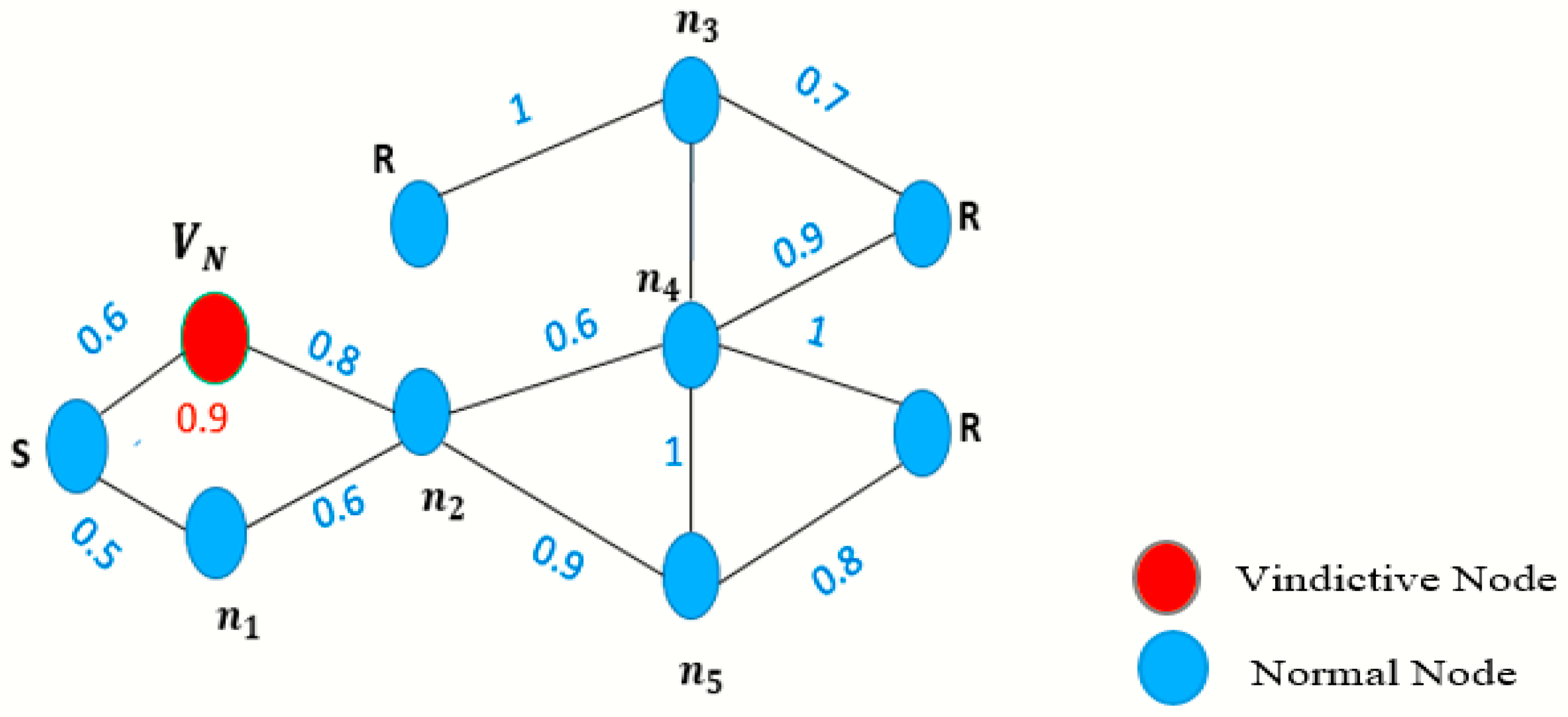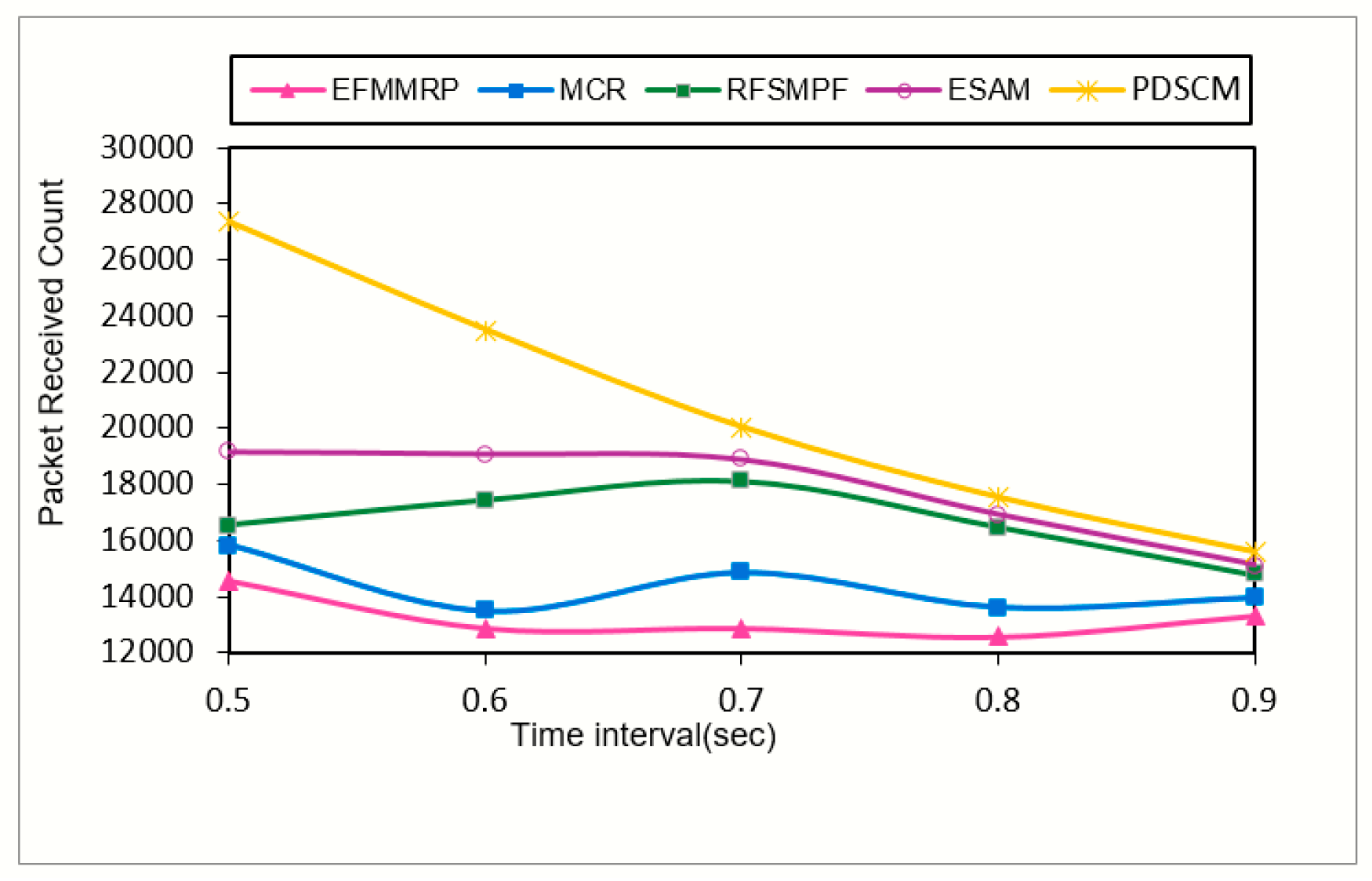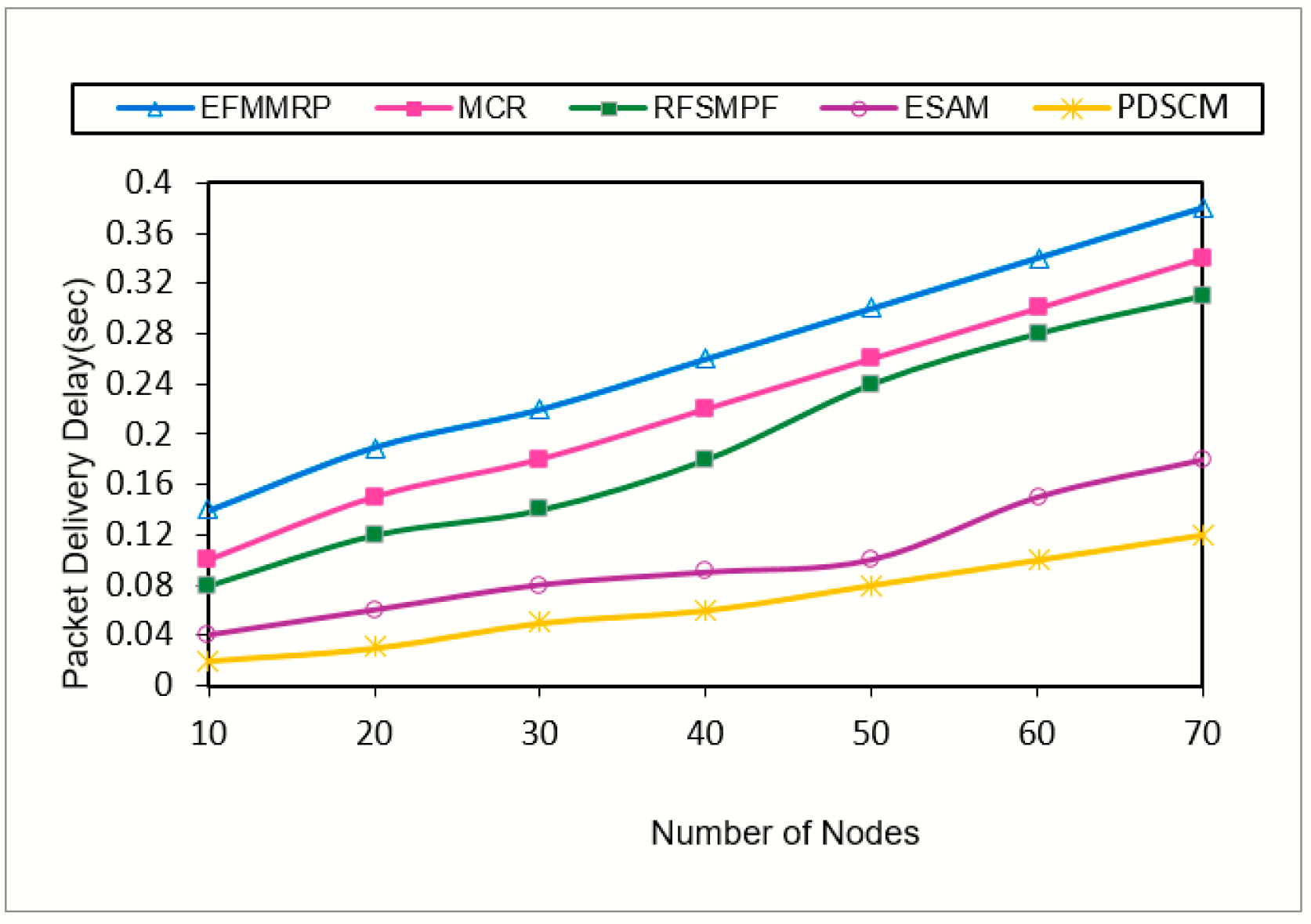PDSCM: Packet Delivery Assured Secure Channel Selection for Multicast Routing in Wireless Mesh Networks
Abstract
1. Introduction
- Creation of data forwarding attacks in wireless mesh networks;
- Computation of network metrics including ongoing delivery ratio and predictable delivery ratio;
- Construction of route discovery phase using the PDSCM protocol;
- Implementation of secure multicast routing using twin- and quad-based computing and the orthogonal projection algorithm;
- Detection of data forwarding attacks and alternate path-finding mechanism.
2. Literature Survey
3. Network Metrics
3.1. Ongoing Delivery ) Ratio
3.2. Predictable Delivery ( Ratio
4. Description of Data Forwarding Attack
5. The Proposed PDSCM Protocol
5.1. Network Model
5.2. PDSCM Algorithm
| Algorithm 1 PDSCM algorithm to ensure secure next-hop forwarder in a multicast mesh network using PDSCM protocol. |
| Step 1: Input the network parameters. Step 2: If the next-hop neighbor is not in the , then the compute node’s initial parameter Step 3: Compute metrics where of a communication link is measured from continuous observations of each one-hop forwarding node for an expected packet delivery ratio. Step 4: Perform secure forwarder node selection * Step 5: If a vindictive node is found, then add its node ID to the . Step 6: Compute authentication signature for the accuser node using RSA encryption, which is used for signature generation and verification based on node ID along with the data packets. Step 7: Send an allegation message in the network. The allegation message includes the node ID of both the accused node and the accuser along with the signature of the accuser. Step 8: Perform signature verification for the accuser during the allegation message exchange. Step 9: Upon successful validation of an allegation message, the accused nodes are marked as vindictive by adding a corresponding node entry to the , and the same node is removed from the current data transmission path. Step 10: End. |
5.3. Initialization Phase
- 1.
- Every node in the network shares the hello packet and builds the neighbor list to maintain the current neighbors periodically.
- 2.
- The initial next-hop forwarder selection is based on the initial parameter () metric, which is computed based on the location information () of the neighboring nodes and the channel capacity () of the wireless link from its neighbors to itself, as mentioned in PDSCM algorithm.
- 3.
- Every node in the network constructs a list of qualified forwarder nodes based on the metric. Whenever communication takes place, the nodes compute the packet delivery capability of their neighboring nodes and measure , metrics periodically.
- 4.
- Each node maintains an allegation list that keeps vindictive information; consequently, the honest nodes eliminate the malicious nodes from the path, and the list gets updated periodically.
- 5.
- To ensure the authentication of nodes in the network, nodes share their signatures enclosed with their node ID along with the data packets. The authentication signature algorithm based on RSA is used for signature generation and verification.
5.4. Path Discovery Phase
- 1.
- If the source node wants to initiate a data transmission and does not have a path to reach the receivers, it broadcasts a JREQ message to a group of receivers.
- 2.
- The JREQ message contains various fields, viz., source address, multicast group address, Seqno, predictable delivery () ratio and ongoing delivery ) ratio fields. The and fields are used to identify the sending and receiving packet ratio at each node. The forwarder node then sends the JREQ message to the group of receiver nodes.
- 3.
- When the set of receiver nodes receive JREQ messages, they verify the message sequence number to ensure the packet’s freshness. If the sequence number is new, then the receivers send a JREP message to the source node through the forwarders based on the best , values recorded among the set of neighbor nodes, as its upstream node towards the source.
- 4.
- The JREP message contains the source address, multicast group address, REPID and return path information. The REPID is a unique ID to identify the JREP message and the return path information field contains path information to send the JREP message back to the source.
- 5.
- When the source node receives JREP message from the recipients, it then starts transmitting the data.
5.5. Secure Forwarder Selection Phase
5.5.1. Vindictive Boundary Detection
Strategy for Identification of the Vindictive Node
Confidence Interval for the Detection of Malicious Nodes
5.5.2. Orthogonal Projection and Estimation
6. Results and Discussion
7. Conclusions
Author Contributions
Funding
Institutional Review Board Statement
Informed Consent Statement
Data Availability Statement
Conflicts of Interest
References
- Khadmaoui-Bichouna, M.; Alcaraz-Calero, J.M.; Wang, Q. Empirical evaluation of 5G and Wi-Fi mesh interworking for Integrated Access and Backhaul networking paradigm. Comput. Commun. 2023, 209, 429–443. [Google Scholar] [CrossRef]
- Quy, V.K.; Chehri, A.; Quy, N.M.; Han, N.D.; Ban, N.T. Innovative Trends in the 6G Era: A Comprehensive Survey of Architecture, Applications, Technologies, and Chal-lenges. IEEE Access 2023, 11, 39824–39844. [Google Scholar] [CrossRef]
- Nouri, N.A.; Aliouat, Z.; Naouri, A.; Hassak, S.A. Accelerated PSO algorithm applied to clients coverage and routers connectivity in wireless mesh net-works. J. Ambient. Intell. Humaniz. Comput. 2023, 14, 207–221. [Google Scholar] [CrossRef]
- Seetha, S.; Anand, J.F.S.; Kanaga, E.G.M. RFSMPF: Rank based forwarder selection in MCAST with fuzzy optimized path formation in wireless mesh network. Wirel. Netw. 2019, 25, 4287–4298. [Google Scholar] [CrossRef]
- Hu, H.; Ye, M.; Zhao, C.; Jiang, Q.; Wang, Y.; Qiu, H.; Deng, X. Intelligent multicast routing method based on multi-agent deep reinforcement learning in SDWN. arXiv 2023, arXiv:2305.10440. [Google Scholar] [CrossRef]
- Yadav, A.K.; Das, S.K.; Tripathi, S. EFMMRP: Design of efficient fuzzy based multi-constraint multicast rout-ing protocol for wireless ad-hoc network. Comput. Netw. 2017, 118, 15–23. [Google Scholar] [CrossRef]
- Murugeswari, R.; Devaraj, D. Multiconstrained QoS Multicast Routing for Wireless Mesh Network Using Discrete Particle Swarm Optimization. In Artificial Intelligence and Evolutionary Computations in Engineering Systems: Proceedings of ICAIECES 2016; Springer: Singapore, 2017; pp. 847–859. [Google Scholar]
- Gupta, B.K.; Patnaik, S.; Nayak, A.K.; Mallick, M.K. Congestion managed multicast routing in wireless mesh network. Int. J. Commun. Netw. Inf. Secur. 2017, 9, 484–490. [Google Scholar] [CrossRef]
- Ibraheem, I.K.; Al-Hussainy, A.A.-H. A multi QoS genetic-based adaptive routing in wireless mesh net-works with Pareto solutions. arXiv 2018, arXiv:1805.00973. [Google Scholar]
- Rao, A.N.; Rao, C.D.V.S. Way-point multicast routing framework for improving QoS in hybrid wireless mesh net-works. Wirel. Netw. 2016, 22, 2681–2694. [Google Scholar]
- Meraihi, Y.; Acheli, D.; Ramdane-Cherif, A. QoS multicast routing for wireless mesh network based on a modified bi-nary bat algorithm. Neural Comput. Appl. 2019, 31, 3057–3073. [Google Scholar] [CrossRef]
- Duchamp, G. Orthogonal projection onto the free Lie algebra. Theor. Comput. Sci. 1991, 79, 227–239. [Google Scholar] [CrossRef]
- Dan, M.; Rabinoff, J.; Rolen, L. Interactive Linear Algebra; Georgia Institute of Technology: Atlanta, GA, USA, 2017. [Google Scholar]
- Wallis, S. Binomial confidence intervals and contingency tests: Mathematical fundamentals and the evaluation of alternative methods. J. Quant. Linguist. 2013, 20, 178–208. [Google Scholar] [CrossRef]
- David, S.M.; Notz, W.I.; Fligner, M.A. The Basic Practice of Statistics; Macmillan Higher Education: New York, NY, USA, 2015. [Google Scholar]
- Seetha, S.; Francis, S.A.J. Secure Multicasting Protocols in Wireless Mesh Networks—A Survey. In Computational Intelligence, Cyber Security and Computational Models: Proceedings of ICC3, 2013; Springer: New Delhi, India, 2014; pp. 245–256. [Google Scholar]
- Li, Y.; Ray, C. Hierarchical agent-based secure multicast for wireless mesh networks. In Proceedings of the 2011 IEEE International Conference on Communications (ICC), Kyoto, Japan, 5–9 June 2011; IEEE: New York, NY, USA, 2011; pp. 1–6. [Google Scholar]
- Shin, S.; Hur, J.; Lee, H.; Yoon, H. Bandwidth efficient key distribution for secure multicast in dynamic wireless mesh networks. In Proceedings of the 2009 IEEE Wireless Communications and Networking Conference, Budapest, Hungary, 5–8 April 2009; IEEE: New York, NY, USA, 2009; pp. 1–6. [Google Scholar]
- Kim, J.; Bahk, S. Design of certification authority using secret redistribution and multicast routing in wireless mesh networks. Comput. Netw. 2009, 53, 98–109. [Google Scholar] [CrossRef]
- Dong, J.; Ackermann, K.; Nita-Rotaru, C. Secure group communication in wireless mesh networks. Ad Hoc Netw. 2009, 7, 1563–1576. [Google Scholar] [CrossRef]
- Balaji, S.; Sasilatha, T. Secure on demand multicast routing for network attacks in wireless mesh network. In Proceedings of the International Conference for Phoenixes on Emerging Current Trends in Engineering and Management (PECTEAM 2018); Atlantis Press: Paris, France, 2018; pp. 20–23. [Google Scholar]
- Matam, R.; Tripathy, S. Secure multicast routing algorithm for wireless mesh networks. J. Comput. Netw. Commun. 2016, 2016, 1563464. [Google Scholar] [CrossRef][Green Version]
- Sharma, B.; Vaid, R. Efficient Key Management for Secure Communication Within Tree and Mesh-Based Multicast Routing Protocols. In Mobile Radio Communications and 5G Networks: Proceedings of Second MRCN 2021; Springer Nature: Singapore, 2022; pp. 501–510. [Google Scholar]
- Sharma, B.; Vaid, R. A Secure Key Management on ODMRP in Mesh-Based Multicast Network. In Computational Intelligence for Engineering and Management Applications: Select Proceedings of CIEMA 2022; Springer Nature: Singapore, 2023; pp. 521–530. [Google Scholar]
- Dong, J.; Curtmola, R.; Nita-Rotaru, C. Secure network coding for wireless mesh networks: Threats, challenges, and directions. Comput. Commun. 2009, 32, 1790–1801. [Google Scholar] [CrossRef]
- Anwar, A.L.H.; Barakat, C.; Turletti, T. Network coding for wireless mesh networks: A case study. In Proceedings of the 2006 International Symposium on a World of Wireless, Mobile and Multimedia Networks (WoWMoM’06), Buffalo-Niagara Falls, NY, USA, 26–29 June 2006; IEEE: New York, NY, USA, 2006; p. 9. [Google Scholar]
- Chen, P.; Shi, L.; Fang, Y.; Lau, F.C.M.; Cheng, J. Rate-diverse multiple access over Gaussian channels. IEEE Trans. Wirel. Commun. 2023, 22, 5399–5413. [Google Scholar] [CrossRef]
- Jeyakarthic, M.; Subalakshmi, N. Energy saving slot allocation-based multicast routing in cloud wireless mesh net-work. Int. J. Cloud Comput. 2023, 12, 148–162. [Google Scholar] [CrossRef]
- Fathima, M.A.; Munsifa, A.F. Mobile agent platforms in ubiquitous computing applications and systems (a literature review). In Proceedings of the 6th International Symposium, Heidelberg, Germany, 11–15 July 2016. [Google Scholar]








| Channel/Link | PD | OD |
|---|---|---|
| 8- > 5 | 1 | 0.701 |
| 32- > 5 | 1 | 0.673 |
| Link | X | Lower Limit | Upper Limit | |
|---|---|---|---|---|
| 1- > 34 | 0.714286 | 0.334664 | 0.379622 | 1.04895 |
| Parameter | Value |
|---|---|
| Radio-propagation model | Random waypoint model |
| MAC type | Mac/802_11 |
| Antenna model | Antenna/omni antenna |
| Routing protocol | PDSCM |
| Simulation area | 800 × 800 square meters |
| Nodes | 100 |
| Initial energy in joules | 100 |
| Data packet size | 512 bytes |
| Receiving power | 0.6 W |
| Transmission power | 0.9 W |
| Traffic type | CBR |
| Simulation time | 200 s |
Disclaimer/Publisher’s Note: The statements, opinions and data contained in all publications are solely those of the individual author(s) and contributor(s) and not of MDPI and/or the editor(s). MDPI and/or the editor(s) disclaim responsibility for any injury to people or property resulting from any ideas, methods, instructions or products referred to in the content. |
© 2023 by the authors. Licensee MDPI, Basel, Switzerland. This article is an open access article distributed under the terms and conditions of the Creative Commons Attribution (CC BY) license (https://creativecommons.org/licenses/by/4.0/).
Share and Cite
S, S.; Daniel, E.; Durga, S.; Eunice R, J.; J, A. PDSCM: Packet Delivery Assured Secure Channel Selection for Multicast Routing in Wireless Mesh Networks. Technologies 2023, 11, 130. https://doi.org/10.3390/technologies11050130
S S, Daniel E, Durga S, Eunice R J, J A. PDSCM: Packet Delivery Assured Secure Channel Selection for Multicast Routing in Wireless Mesh Networks. Technologies. 2023; 11(5):130. https://doi.org/10.3390/technologies11050130
Chicago/Turabian StyleS, Seetha, Esther Daniel, S Durga, Jennifer Eunice R, and Andrew J. 2023. "PDSCM: Packet Delivery Assured Secure Channel Selection for Multicast Routing in Wireless Mesh Networks" Technologies 11, no. 5: 130. https://doi.org/10.3390/technologies11050130
APA StyleS, S., Daniel, E., Durga, S., Eunice R, J., & J, A. (2023). PDSCM: Packet Delivery Assured Secure Channel Selection for Multicast Routing in Wireless Mesh Networks. Technologies, 11(5), 130. https://doi.org/10.3390/technologies11050130






